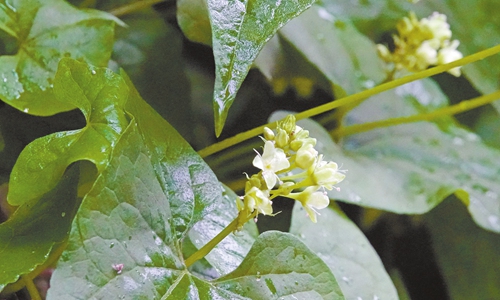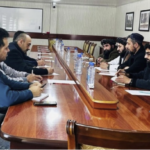By Sun Langchen

A tougucao plant Photo: VCG
In late-spring sunlight, the winding paths of Baligou scenic area in the southern Taihang Mountains in Central China’s Henan Province is a vibrant mix of languages and laughter. Among the cliffs and valleys, 20 international students transform into apprentice herbalists on a quest for medicinal plants.
“Just take a look at this leaf – it’s like a whipsaw blade. This must be tougucao (Herb Tuberculate Speranskia) right?” asked Usman, a senior student from Pakistan.
A nearby herb farmer nodded, plucking the plant and explaining its use in treating bruises and sprains. Usman translated the explanation into his mother tongue for his older brother Wali, also a student and companion on this unique journey.
This is an all too familiar scene at the immersive “Climb the Taihang, Gather the Herbs” event held on May 19. Zhang Yi, CEO of the iiMedia Research Institute, told the Global Times that with the increasing number of such activities, the experience economy is likely to see a new trend of “TCM-tourism integration.”
“The influence of traditional Chinese medicine (TCM) in the world has grown significantly in recent years, fundamentally because TCM, as an important part of 5,000 years of Chinese culture, is increasingly being recognized, appreciated, and studied,” he said.
Mountains rich with medicine
With more than 1,017 medicinal species, the southern reaches of the Taihang Mountains have long been known as a “natural pharmacy” in China. Famous herbs such as forsythia, hawthorn, bupleurum, and safflower flourish here. For centuries, the area has attracted herbalists, traders, and now, a new wave of international students eager to bridge Eastern wisdom with global healthcare.
Zhang Zhengxin, a retired herb farmer in his 70s who now volunteers as a guide, has spent nearly three decades leading students into the hills. “These days, the ones most curious about Chinese medicine are young and increasingly international,” he said, noting his first impression of Usman, his Pakistani student.
Usman is about to graduate from Xinxiang Medical University in Henan Province, and he dreams of one day opening a TCM clinic in Pakistan. “I want to bring this knowledge back home,” he said. “In my country, many people still rely on herbs. What I’m learning here has real meaning.”
Also among the most enthusiastic students was Rui Long from Morocco, who clutched a pod of bayuezha, directly translates as “August Burst” with wide-eyed curiosity, as reported by China News Service. “Why is it called that?” he asked. A local expert explained that the fruit bursts open when ripe in the eighth lunar month, symbolizing the harmony between time and nature.
Taihang’s medicinal ecology forms the backdrop of a broader movement: Integrating TCM with tourism and education to create multisensory, hands-on experiences. A student group led by popular German TCM advocate Wu Ming, is such an example. Taking two days per month to go into the mountains to gather herbs, this now social media influencer has spent years in Henan studying Chinese medicine.
“Southern Taihang Mountains offer not just rich resources but a whole-body cultural experience,” Wu Ming told the Global Times. “You hike, you learn, you breathe in the fragrance of herbs, and you understand health as harmony with nature.”
International practitioners
As a foreigner who is now recognized in villages across Henan as a “Western practitioner in Chinese medicine,” Wu Ming believes that TCM is uniquely positioned in today’s global health context.
The 2025 flu treatment protocol issued by China’s National Health Commission emphasizes TCM’s unique diagnostic framework, distinguishing conditions by symptoms and seasonal patterns rather than names of diseases alone.
Zhang noted this is precisely what attracts international students: “They appreciate that TCM isn’t just about curing disease, but about understanding the person in context: Body, season, and environment.”
Several students shared stories of how their own minor ailments had been treated using herbal remedies. Freshman Li Tian recalled sipping xiangchacai (Isodon) for mouth ulcers. “It worked faster than I’d expected,” she said. “I want to learn more, not just for myself, but to help others.”
From chrysanthemums for throat pain to heshouwu (Fallopia multiflora) for vitality, each plant these students encountered was a lesson in both science and history. To further this learning, the local tourism bureau has developed experiential curricula in places like Baligou, blending fieldwork with traditional classroom instruction. Fu Jiuchen, a local tourism official, told the Global Times that the goal is to make TCM tangible for all ages.
“For students, touching real plants, processing them, and even brewing teas, brings life to what might otherwise remain as just words on paper,” Fu said.
And for many of the international students, this living legacy may shape their future careers. Usman hopes to return to his country not only as a doctor but as a TCM philosophy ambassador. Rui Long is considering postgraduate research on cross-cultural herbal medicine. Wu Ming continues to popularize TCM through videos and community workshops, offering international audiences a window to Chinese culture.
Zhang noted this phenomenon has become increasingly prominent along the path of medicine-tourism integration, as more international visitors are discovering a part of themselves through their exploration of China’s rich culture, which they resonate with.











